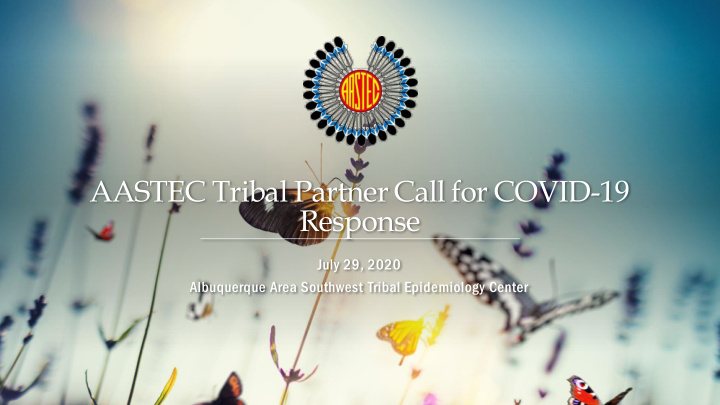



AASTEC Tribal Partner Call for COVID-19 Response July 29, 2020 Albuquerque Area Southwest Tribal Epidemiology Center
◦ Amy Dixit , AASTEC Epidemiologist, adixit@aaihb.org ◦ Carolyn Parshall , AASTEC Epidemiologist, cparshall@aaihb.org ◦ Eudora Claw , AASTEC Epidemiologist, eclaw@aaihb.org ◦ Kevin English , AASTEC Director, kenglish@aaihb.org Welcome ◦ Michele Suina , GHWIC Program Director, msuina@aaihb.org ◦ AASTEC website: www.aastec.net ◦ AASTEC Facebook Page: www.facebook.com/aaihb.aastec ◦ AASTEC Instagram:www.instagram.com/aaihb.aastec
COVID- 19 Updates Navajo Nation National Regional and AASTEC Rapid Response Updates State Updates Updates Team Updates
National Updates ◦ Vaccine update: Phase 3 trials for a Moderna vaccine designed to evaluate the safety of mRNA-1273 and to determine if the vaccine can prevent symptomatic COVID-19 after two doses. As secondary goals, the trial also aims to study whether the vaccine can prevent severe COVID-19 or laboratory-confirmed SARS-CoV-2 infection with or without disease symptoms. The trial also seeks to answer if the vaccine can prevent death caused by COVID-19 and whether just one dose can prevent symptomatic COVID-19, among other objectives. ◦ https://www.nih.gov/news-events/news-releases/phase-3-clinical-trial-investigational-vaccine-covid-19-begins ◦ Many other vaccines in a similar position at different companies around the world. Moderna's is the one in US. ◦ New federal report places 21 states in the "RED ZONE": https://int.nyt.com/data/documenttools/states-report- virus-response-july-26/e241189157b34378/full.pdf ◦ AZ in "RED ZONE"- more than 100 new cases per 100,000 population in the last week, and the red zone for test positivity, indicating a rate above 10 % . ◦ CO in "YELLOW ZONE"- between 10 to 100 new cases per 100,000 population in the last week, and the yellow zone for test positivity, indicating a rate between 5 % to 10 % . ◦ NM in "YELLOW ZONE"- between 10 to 100 new cases per 100,000 population in the last week, and the green zone for test positivity, indicating a rate below 5 %. ◦ TX in "RED ZONE"- more than 100 new cases per 100,000 population in the last week, and the red zone for test positivity, indicating a rate above 10 % . ◦ National Teachers' Union supports strikes by local chapters over reopening plans.
Regional and State Updates Cases per Cases in the last 7 Deaths per Percent Positive 100,000 days per 100,000 100,000 (7-day moving average) Arizona 2,281 237 47 20.7% Texas 1,423 197 22 12.1% Colorado 789 74 31 8.1% New Mexico 944 108 30 4.4% https://coronavirus.jhu.edu/testing/individual-states/texas https://www.nytimes.com/interactive/2020/us/coronavirus-us-cases.html#states
http://db.aastec.net/covid-19/index.html http://www.aaihb.org/covid-19-resources-.aspx AASTEC Updates
New CDC Guidance ◦ Please recall that the test-based strategy is NOT recommended to determine a return to work. ◦ For those with severe to critical illness or who are severely immunocompromised, the recommended duration for work exclusion was extended to 20 days after symptom onset (or, for asymptomatic severely immunocompromised, 20 days after their initial positive SARS-CoV-2 diagnostic test). ◦ Other symptom-based criteria were modified as follows: ◦ Changed from “at least 72 hours” to “at least 24 hours” have passed since last fever without the use of fever-reducing medications ◦ Changed from “improvement in respiratory symptoms” to “improvement in symptoms” to address expanding list of symptoms associated with COVID-19 https://www.cdc.gov/coronavirus/2019-ncov/hcp/return-to-work.html?CDC_AA_refVal=https%3A%2F%2Fwww.cdc.gov%2Fcoronavirus%2F2019-ncov%2Fhealthcare-facilities%2Fhcp-return-work.html
CDC Q&A A person who previously tested positive by RT-PCR for SARS-CoV-2 and clinically recovered from COVID-19 is later tested again, for example as part of a contact tracing investigation. IF that person again tests positive by RT-PCR, should they be managed as potentially infectious to others, and isolated again for COVID-19? It depends While the guidance still recommends AGAINST retesting, if the previously recovered person were to test positive again 90 days or more after their initial infections, the person should be managed as potentially infectious and isolated. At that point, it should be treated as a new case and their contacts should be retraced and quarantined while the case remains isolated until they have recovered again. https://www.cdc.gov/coronavirus/2019-ncov/hcp/faq.html
If a previously infected person has clinically recovered but later develops symptoms consistent with COVID-19, should the person be isolated again and tested for SARS-CoV-2? It depends Persons who develop new symptoms consistent with COVID-19 more than 3 months after the date of symptom onset of the most recent illness episode should be retested. Persons with recurrent symptoms after the first 3 months who test positive should be considered infectious and remain isolated until they again meet criteria for discontinuation of isolation or of transmission- based precautions. Contact tracing during the person’s second period of symptoms is warranted. For persons who develop new symptoms consistent with COVID-19 during the first 3 months since the date of symptom onset of the most recent illness episode, retesting may be warranted if alternative etiologies for the illness cannot be identified. If reinfection is suspected, repeat isolation and contact tracing may be needed. The determination of whether a patient with a subsequently positive test is contagious to others should be made on a case-by-case basis, in consultation with infectious diseases specialists and public health authorities, after review of available information (e.g., medical history, time from initial positive test, RT-PCR Ct values, and presence of COVID-19 signs or symptoms). https://www.cdc.gov/coronavirus/2019-ncov/hcp/faq.html
If an infected person has clinically recovered and then later is identified as a contact as a new case, do they need to be quarantined? It depends A person who has clinically recovered from COVID-19 and then is identified as a contact of a new case within 3 months of symptom onset of their most recent illness does not need to be quarantined or retested for SARS-CoV-2. However, if a person is identified as a contact of a new case 3 months or more after symptom onset, they should follow quarantine recommendations for contacts. https://www.cdc.gov/coronavirus/2019-ncov/hcp/faq.html
Recommend
More recommend